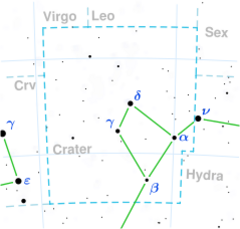Astronomy:Iota Crateris
| Observation data Equinox J2000.0]] (ICRS) | |
|---|---|
| Constellation | Crater |
| Right ascension | 11h 38m 40.01668s[1] |
| Declination | −13° 12′ 06.9963″[1] |
| Apparent magnitude (V) | 5.48[2] |
| Characteristics | |
| Spectral type | F6.5 V[3] |
| B−V color index | +0.52[2] |
| Astrometry | |
| Radial velocity (Rv) | −26.6±0.3[4] km/s |
| Proper motion (μ) | RA: +99.52[1] mas/yr Dec.: +125.99[1] mas/yr |
| Parallax (π) | 37.41 ± 0.30[1] mas |
| Distance | 87.2 ± 0.7 ly (26.7 ± 0.2 pc) |
| Absolute magnitude (MV) | +3.33[5] |
| Details | |
| ι Crt A | |
| Mass | 1.19+0.06 −0.02[6] M☉ |
| Surface gravity (log g) | 4.27±0.03[7] cgs |
| Temperature | 6,230±21[7] K |
| Metallicity [Fe/H] | −0.15±0.01[7] dex |
| Age | 4.45+0.32 −0.94[6] Gyr |
| ι Crt B | |
| Mass | 0.57[8] M☉ |
| Other designations | |
| Database references | |
| SIMBAD | data |
Iota Crateris (ι Crateris) is the Bayer designation for a binary star[10] system in the southern constellation of Crater. It is faintly visible to the naked eye with an apparent visual magnitude of 5.48.[2] According to the Bortle scale, this means it can be viewed from suburban skies at night. Based upon an annual parallax shift of 37.41 mas,[1] Iota Crateris is located 87 light years from the Sun.
This is an astrometric binary system with an estimated orbital period of roughly 79,000 years.[10] The primary, component A, is an F-type main sequence star with a stellar classification of F6.5 V,[3] which is generating energy through the thermonuclear fusion of hydrogen in its core region. It is around 4.45[6] billion years old with 1.19[6] times the mass of the Sun. The star is radiating energy from its outer atmosphere at an effective temperature of 6,230 K.[7]
The companion, component B, is a red dwarf star with a probable classification of M3, although its mass estimate of 0.57 solar would be more consistent with an M0 class star.[8] As of 2014, this magnitude 11.0 star had an angular separation of 1.10 arc seconds along a position angle of 248°.[11] It has a projected separation of 25 AU,[8] which means it is positioned at least this distance away from the primary.
References
- ↑ 1.0 1.1 1.2 1.3 1.4 1.5 van Leeuwen, F. (2007), "Validation of the new Hipparcos reduction", Astronomy and Astrophysics 474 (2): 653–664, doi:10.1051/0004-6361:20078357, Bibcode: 2007A&A...474..653V.
- ↑ 2.0 2.1 2.2 Corben, P. M.; Stoy, R. H. (1968), "Photoelectric Magnitudes and Colours for Bright Southern Stars", Monthly Notes of the Astronomical Society of Southern Africa 27: 11, Bibcode: 1968MNSSA..27...11C.
- ↑ 3.0 3.1 Gray, R. O. et al. (July 2006), "Contributions to the Nearby Stars (NStars) Project: spectroscopy of stars earlier than M0 within 40 pc-The Southern Sample", The Astronomical Journal 132 (1): 161–170, doi:10.1086/504637, Bibcode: 2006AJ....132..161G.
- ↑ de Bruijne, J. H. J.; Eilers, A.-C. (October 2012), "Radial velocities for the HIPPARCOS-Gaia Hundred-Thousand-Proper-Motion project", Astronomy & Astrophysics 546: 14, doi:10.1051/0004-6361/201219219, A61, Bibcode: 2012A&A...546A..61D.
- ↑ Lambert, David L.; Reddy, Bacham E. (April 2004), "Lithium abundances of the local thin disc stars", Monthly Notices of the Royal Astronomical Society 349 (2): 757−767, doi:10.1111/j.1365-2966.2004.07557.x, Bibcode: 2004MNRAS.349..757L.
- ↑ 6.0 6.1 6.2 6.3 Ramírez, I. et al. (September 2012), "Lithium Abundances in nearby FGK Dwarf and Subgiant Stars: Internal Destruction, Galactic Chemical Evolution, and Exoplanets", The Astrophysical Journal 756 (1): 46, doi:10.1088/0004-637X/756/1/46, Bibcode: 2012ApJ...756...46R.
- ↑ 7.0 7.1 7.2 7.3 Adibekyan, V. et al. (August 2016), "Abundance trend with condensation temperature for stars with different Galactic birth places", Astronomy & Astrophysics 592: 12, doi:10.1051/0004-6361/201628883, A87, Bibcode: 2016A&A...592A..87A.
- ↑ 8.0 8.1 8.2 Ehrenreich, D. et al. (November 2010), "Deep infrared imaging of close companions to austral A- and F-type stars", Astronomy and Astrophysics 523: 41, doi:10.1051/0004-6361/201014763, A73, Bibcode: 2010A&A...523A..73E.
- ↑ "iot Crt -- Star", SIMBAD Astronomical Database (Centre de Données astronomiques de Strasbourg), http://simbad.u-strasbg.fr/simbad/sim-id?Ident=iot+Crt, retrieved 2017-02-26.
- ↑ 10.0 10.1 Tokovinin, Andrei (2014), "From Binaries to Multiples. II. Hierarchical Multiplicity of F and G Dwarfs", The Astronomical Journal 147 (4): 14, doi:10.1088/0004-6256/147/4/87, 87, Bibcode: 2014AJ....147...87T.
- ↑ Mason, B. D. et al. (2014), "The Washington Visual Double Star Catalog", The Astronomical Journal 122 (6): 3466–3471, doi:10.1086/323920, Bibcode: 2001AJ....122.3466M.
 |


